Monday, August 13Yesterday we walked practically the entire length of the Canal St. Martin through the 10th and 11th arrondissements of Paris. We realized that we have spent almost no time in these two arrondissements, and the weather was perfect, so it was time to make amends. Off to the top of the tenth we went. At Place de la Bataille de Stalingrad, we looked out at the Basin de la Villette, which is big because it is where several canals merge. (photo at right) The high rises are in the 19th arrondissement. They are an unfortunate feature of that area. At the top of the tenth, we found ourselves at the top of a long, gently sloping hill. This canal goes down to the Seine, so there are several locks that boats must pass through in order to get from one end to the other. We realized right away that this must be a part of a network of canals connecting rivers in northern Europe, because the first two boats we saw were the Adagio, from Brussels, which was headed in the same direction we were going (toward the Seine), and another boat, shown here, which was going home to Antwerp (the opposite direction). The boats enter the lock, then loop a couple lines over some device that goes up and down with the water level. When the water reaches the appropriate level, the doors to the next section open, and the people on the boat unhook their ropes and move on down the canal. |
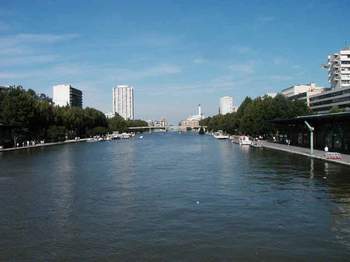 |
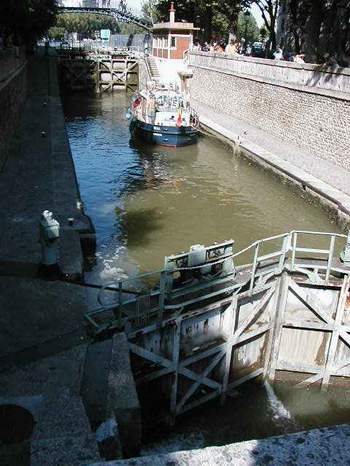 |
|
| Before we get too far down the canal, I wanted to
show you this odd building we saw in the Place de la Bataille de Stalingrad. The
Place is built over the uppermost part of the Canal St. Martin, so here the boats are
passing through a tunnel underneath. The Michelin guide says this is the Rotonde de la Villette (circa 1784-87), one of a ring of tollhouses that now serves as a storehouse for archeological finds. Other reading tells me that this was also the place where, on March 1, 1814, France capitulated to the Russians and Prussians who entered the city of Paris the next day. You can just make out an elevated Métro line behind the Rotonde. Vibrations from the train cracked the building, necessitating restoration work before it could be used for the archeological treasures of the Museum of Paris. And currently, this area is one of the hottest nighttime drug trafficking sites in the city. Even in the daytime, we saw a number of people hanging around who looked like they were looking for customers, but not finding them, among the throngs of tourists and Parisians out for their Sunday strolls. Nearby is this handsome building (at right) which houses some of the canal management offices. |
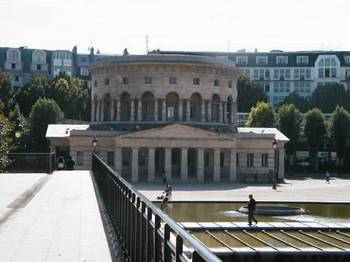 |
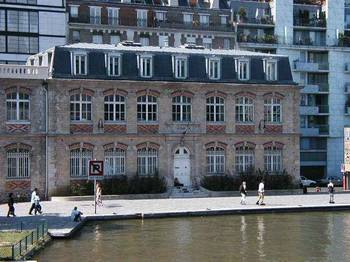 |
|
| Here
is the Adagio, again, appearing to be moving right along. But in reality, true to
its name, it made slow progress down the canal. Mostly this was because of the time
it takes to get through all of the locks. We saw it several times as we walked
along, and we weren't moving fast, either. One owner of the boat seemed to be the man sitting on the bow, and his wife, it seems, was driving the boat. A friend relaxes in back, in the shade. |
 |
| At one of the locks, a manager came out and had a
cheerful conversation with the people of the Adagio. He handed them a paper, which
Madame la Capitaine has here in her hand. Then the manager disappears back into his
hovel. Looks like Monsieur of the Adagio has had a bit too much sun today. We were delighted to find that on Sundays, or at least on some Sundays such as this, the roads alongside the canal are reserved for pedestrians and bicyclists. So, in addition to the little parks scattered along the canal, we had a street without cars at our disposal. The area along the canal, especially on such a beautiful Sunday, was a comfortable place to be. But being in the 10th and 11th and noticing certain things that were similar to (but not as bad as) the 19th and 20th arrondissements made me realize a fundamental truth about Paris. Especially when I later thought about things in the 12th and 13th arrondissements (left bank) that I also did not like as much as the rest of Paris, I suddenly noticed that I was including all of the easternmost parts of the city, from northeast to southeast, in my less favorite places. Of course there are lovely spots in each of these arrondissements -- like the Parc de Bercy in the 12th. But the sum total is that the east is dirtier and less comfortable than the west. What caused this difference? The east has a history of having been home to some places of misery, like the Bastille, La Villette (back in the days when it was a huge, putrid slaughterhouse), and the Hôpital Pitié-Salpêtrière where Paris once incarcerated the least desirable ten percent of its population (40,000 people in a city with 400,000 people at that time). Huge areas devoted to railroad tracks attracted undesirable industries. While industry was also attracted to the 15th, the 15th remained the only arrondissement on the west side to develop in that way, so that now, surrounded by swankiness, the 15th is becoming trendy and nice, too. That trend was also helped along by the disappearance of the factories of the 15th. The last big one to go was the Citroën car factory. But don't avoid the east -- all of Paris is worth seeing. You can see how charming this part of the 10th is. Just don't be surprised if your favorite arrondissements are toward the center or the west. |
 |
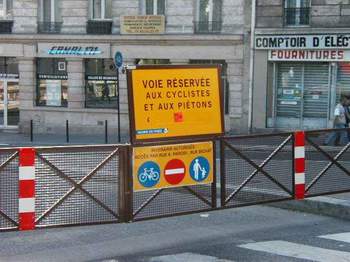 |
|
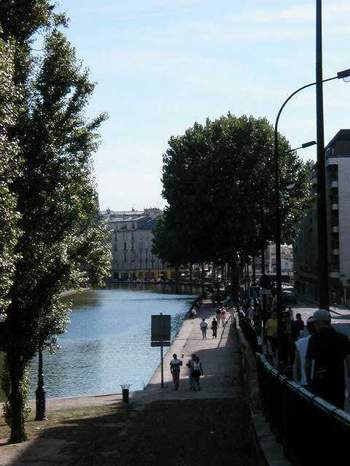 |
|
| This
much larger boat appeared to be French, and it was going in the opposite direction,
preparing to leave Paris for vacation, no doubt. There was a lock ahead of them which was really narrow in one spot, so we waited to see if this fat boat would make it through. |
 |
| The
fat French boat makes it through the narrow spot just fine, with a couple feet to spare.
We weren't alone in watching the boats go through the locks. Lots of people were doing the same thing, and not all of them were tourists. This is just a very pleasant way to spend a Sunday afternoon. The Madame aboard this boat frowned after I took this picture. I just smiled at her. I don't know what she expects in going through a place like this with lots of vacationers and cameras. |
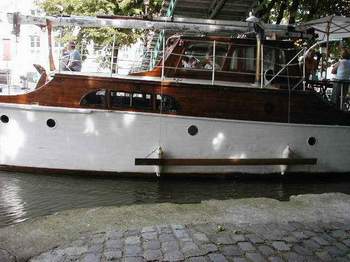 |
| In
addition to the locks, there is another type of mechanism that the boats must wait for.
This one is a swing bridge. Here you see it closed, with auto traffic moving
across the canal. A few weeks ago, when we were at the canal exhibit in the Hôtel de Ville, we saw a little film about the operations of this bridge. The film seemed to be recording one of the last days the bridge was being run by a human being (located in a small brick building to the right of here). Evidently, the bridge is operated by computer or something now. |
 |
| When a boat approaches, the arms come down to stop the auto traffic, and then the bridge lifts slightly and starts to swing open (shown here). |  |